EXAMPLES
Because no single tool or method is universally suitable for preparing fossils, the initial step in any preparation is to consider the best choice of method.
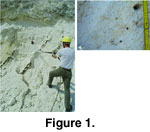 A combination of different methods may work best. Treatment of calcitic encrustations such as worm tubes and bryozoans with gentle waterblasting and the acid-hot water method may provide further information about the fossil record. Prepared fossils are deposited in the Geological Museum, University of Copenhagen (DK and GM numbers).
A combination of different methods may work best. Treatment of calcitic encrustations such as worm tubes and bryozoans with gentle waterblasting and the acid-hot water method may provide further information about the fossil record. Prepared fossils are deposited in the Geological Museum, University of Copenhagen (DK and GM numbers).
Danian octocorals from the Fakse Limestone Quarry, Zealand, Denmark
Together with the Stevns Klint section, the Fakse Limestone Quarry constitutes the type locality of the Danian Stage, which is the lowermost stage of the Paleogene. At Fakse, the Bryozoan Limestone is interbedded with Coral Limestone within a large coral-bryozoan mound complex
(Floris 1980; Willumsen 1995;
Surlyk
1997).  The Bryozoan Limestone contains abundant octocorals in places. Surfaces of blocks containing the octocoral,
Moltkia isis Steenstrup, 1847, were cleaned by the large-scale waterblasting technique
(Figure 1, Figure
2). To remove the matrix surrounding the octocorals, an ordinary pressure washer (Alto Dynamic X-tra, Kew Technology) was applied.
The Bryozoan Limestone contains abundant octocorals in places. Surfaces of blocks containing the octocoral,
Moltkia isis Steenstrup, 1847, were cleaned by the large-scale waterblasting technique
(Figure 1, Figure
2). To remove the matrix surrounding the octocorals, an ordinary pressure washer (Alto Dynamic X-tra, Kew Technology) was applied.
Lower Campanian brachiopods from Ivö Klack, Scania, Sweden
 Marine skeletal sands, which may be characterised as shell banks consisting in the main of oysters and other sessile bivalves, occur on the Swedish island Ivö Klack. An uppermost Lower Campanian age is indicated by belemnites
(Christensen
1975). Large specimens of the inarticulate brachiopod
Crania stobaei Lundgren, 1885 (up to 30 mm in size) are common within the sands. The shells of
C. stobaei are usually filled with consolidated sediment that covers internal morphological features such as muscle scars. Clearing by using air scribes, scrapers and other mechanical aids has hitherto been the only way of exposing the inner shell surfaces. Preparation by combining the acid-hot water method and waterblasting has produced fine results, even over short time periods
(Figure 3, Figure
4).
Marine skeletal sands, which may be characterised as shell banks consisting in the main of oysters and other sessile bivalves, occur on the Swedish island Ivö Klack. An uppermost Lower Campanian age is indicated by belemnites
(Christensen
1975). Large specimens of the inarticulate brachiopod
Crania stobaei Lundgren, 1885 (up to 30 mm in size) are common within the sands. The shells of
C. stobaei are usually filled with consolidated sediment that covers internal morphological features such as muscle scars. Clearing by using air scribes, scrapers and other mechanical aids has hitherto been the only way of exposing the inner shell surfaces. Preparation by combining the acid-hot water method and waterblasting has produced fine results, even over short time periods
(Figure 3, Figure
4).
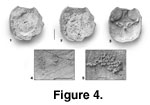 Procedure:
Procedure:
1. Before preparation, the specimen must be impregnated with a suitable lacquer on the outer shell surface. Otherwise, the thin shells disintegrate during processing. When the lacquer is dry, the specimen is treated with concentrated acetic acid.
2. Concentrated acetic acid is poured over the specimen. A wash bottle may be used to apply the acid locally on matrix. Application of acetic acid should be done repeatedly until the matrix has absorbed sufficient acid.
3. After 10 minutes, the acid-treated specimen is transferred to a container of suitable size, and plenty of boiling water is poured over the specimen. A vigorous effervescence of carbon dioxide is caused by the mixture of the acid and the water. When bubbles of carbon dioxide can no longer be observed in the solution (about 20 to 30 minutes), the specimen is removed and cleaned with a Wagner watergun at maximum working pressure. The treatment with acid and boiling water softens the matrix, allowing high-pressure washing to completely remove it.
4. The specimen is then carefully washed in water to avoid the formation of calcium acetate crystals, which may be destructive. The specimen is then dried in an oven for about three hours at 50°C.
5. The procedure is repeated until all matrix is removed. The specimen illustrated in
Figure 4 had two treatments following the described procedure
(Figure 4.1-4.3). The complete process took about six hours.
Remarks: Boiling water may damage shells by exploiting pre-existing shell weaknesses. These weaknesses probably originate from earlier sediment compaction, and the treatment may exacerbate them.
Middle Danian echinoderms from Stevns Klint, Zealand, Denmark
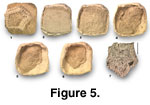 Bryozoan wackestone and packstone mounds are well exposed within the Stevns Klint section, Zealand
(Surlyk 1997;
Surlyk and Hĺkansson
1999). The mounds, which are Danian in age, consist of fragmented bryozoans within chalk-like debris of coccoliths, thoracospheres, foraminifers and invertebrate shells. Brachiopods, serpulids, echinoids, crinoids and octocorals are common
(Surlyk
1997). Recently, a complete specimen of the asteroid,
Metopaster kagstrupensis Brünnich Nielsen, 1943, was collected from Middle Danian wackestone at Stevns Klint. The specimen needed preparation to uncover morphological features of the obscured side of the asteroid
(Figure 5).
Bryozoan wackestone and packstone mounds are well exposed within the Stevns Klint section, Zealand
(Surlyk 1997;
Surlyk and Hĺkansson
1999). The mounds, which are Danian in age, consist of fragmented bryozoans within chalk-like debris of coccoliths, thoracospheres, foraminifers and invertebrate shells. Brachiopods, serpulids, echinoids, crinoids and octocorals are common
(Surlyk
1997). Recently, a complete specimen of the asteroid,
Metopaster kagstrupensis Brünnich Nielsen, 1943, was collected from Middle Danian wackestone at Stevns Klint. The specimen needed preparation to uncover morphological features of the obscured side of the asteroid
(Figure 5).
Procedure:
1. The preparation of the asteroid was more complex than the cleaning of inarticulate brachiopods. The specimen and the enclosed matrix were pre-treated with Synocryl 9122x (acryl-polymer)
(Cray Valley Products
Ltd.) to withstand possible
disaggregation.
2. Additional strengthening of the specimen was obtained by covering one side of the specimen with plaster of Paris
(Figure 5.2). The plaster jacket provided a base against which the uncovered side could be cleaned without breaking the skeletal plates
(Pojeta and Balanc
1989).
3. To loosen the matrix covering the specimen, concentrated acetic acid and boiling water were applied locally. Then the specimen was dried overnight at 50°C. The acid-hot water method was repeated four times
(Figure 5.3-5.6).
4. After cleaning, the plaster jacket was removed mechanically, and the underside of the specimen became visible
(Figure 5.7). 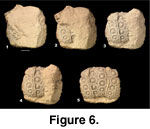 The duration of the preparation was about two hours. In similar cases, hydrated tri-sodium citrate (Na3C6H5O7 2H2O) may be used to break down the plaster of Paris
(Pojeta and Balanc
1989).
The duration of the preparation was about two hours. In similar cases, hydrated tri-sodium citrate (Na3C6H5O7 2H2O) may be used to break down the plaster of Paris
(Pojeta and Balanc
1989).
In addition, the Stevns Klint section yielded Middle Danian specimens of regular echinoids with attached skeletal plates. A regular echinoid recovered from the bryozoan wackestone was successfully prepared by the aims of needles and waterblasting technique
(Figure 6). The Wagner watergun proved suitable for cleaning the specimen, which can be referred to
Typocidaris danica Ravn, 1928. According to
Smith and Jeffery
(2000), T. danica is a junior synonym for
Temnocidaris (Stereocidaris) arnaudi (Lambert
1909).
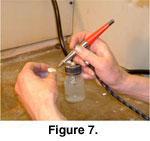 Maastrichtian bivalves from Stevns Chalk Quarry, Zealand, Denmark
Maastrichtian bivalves from Stevns Chalk Quarry, Zealand, Denmark
The Upper Maastrichtian White Chalk is well exposed at the Stevns Chalk Quarry, which is adjacent to Stevns Klint. Calcitic shells of bivalves are commonly well preserved within the White Chalk. Shells of different species were carefully prepared by the use of small-scale wetblasting with carborundum powder (Paasche airbrush)
(Figure 7, Figure
8). To avoid damage of the shells during preparation, their inner surfaces were embedded in epoxy ("Strong Epoxy, Rapid," product no. 2806, company Casco).
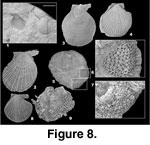 The preparation, which took a few minutes for each shell, revealed subtle details of external morphological features such as radial ribs and scales. Encrustations of bryozoan colonies were also preserved unaffected by the wetblasting
(Figure 8.6-8.7).
The preparation, which took a few minutes for each shell, revealed subtle details of external morphological features such as radial ribs and scales. Encrustations of bryozoan colonies were also preserved unaffected by the wetblasting
(Figure 8.6-8.7).

 A combination of different methods may work best. Treatment of calcitic encrustations such as worm tubes and bryozoans with gentle waterblasting and the acid-hot water method may provide further information about the fossil record. Prepared fossils are deposited in the Geological Museum, University of Copenhagen (DK and GM numbers).
A combination of different methods may work best. Treatment of calcitic encrustations such as worm tubes and bryozoans with gentle waterblasting and the acid-hot water method may provide further information about the fossil record. Prepared fossils are deposited in the Geological Museum, University of Copenhagen (DK and GM numbers).


 Procedure:
Procedure:


 Maastrichtian bivalves from Stevns Chalk Quarry, Zealand, Denmark
Maastrichtian bivalves from Stevns Chalk Quarry, Zealand, Denmark
